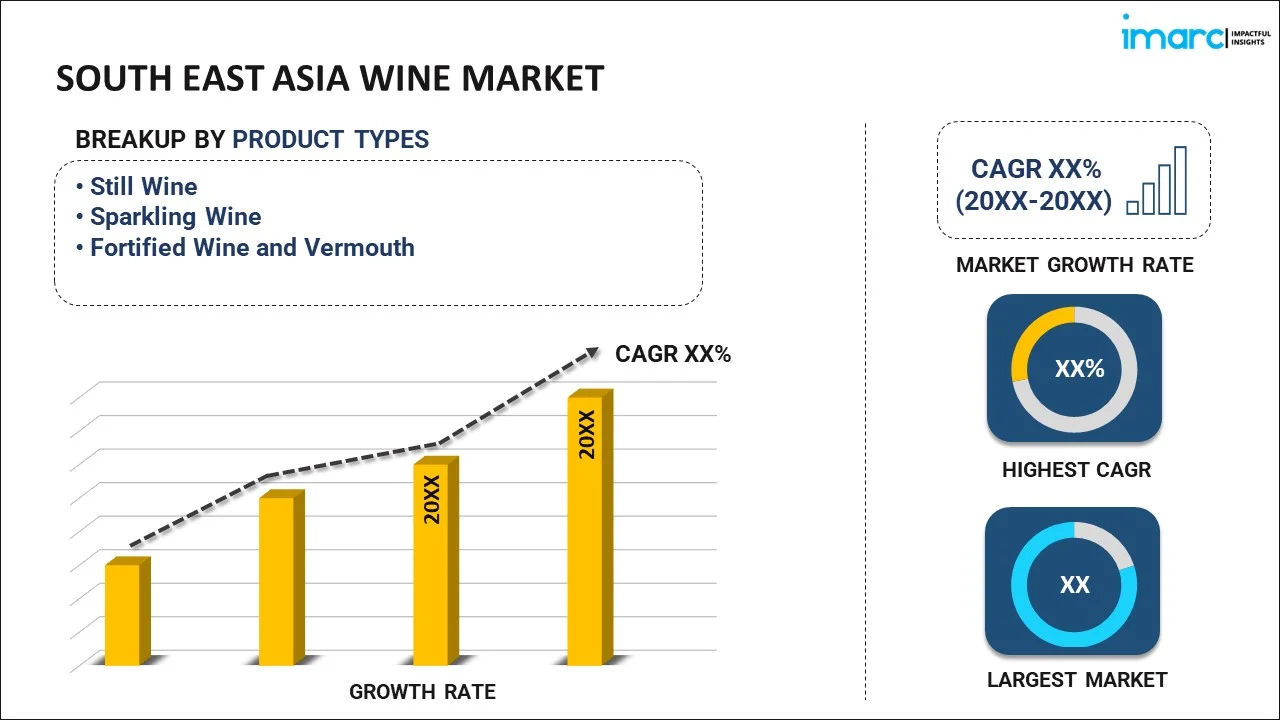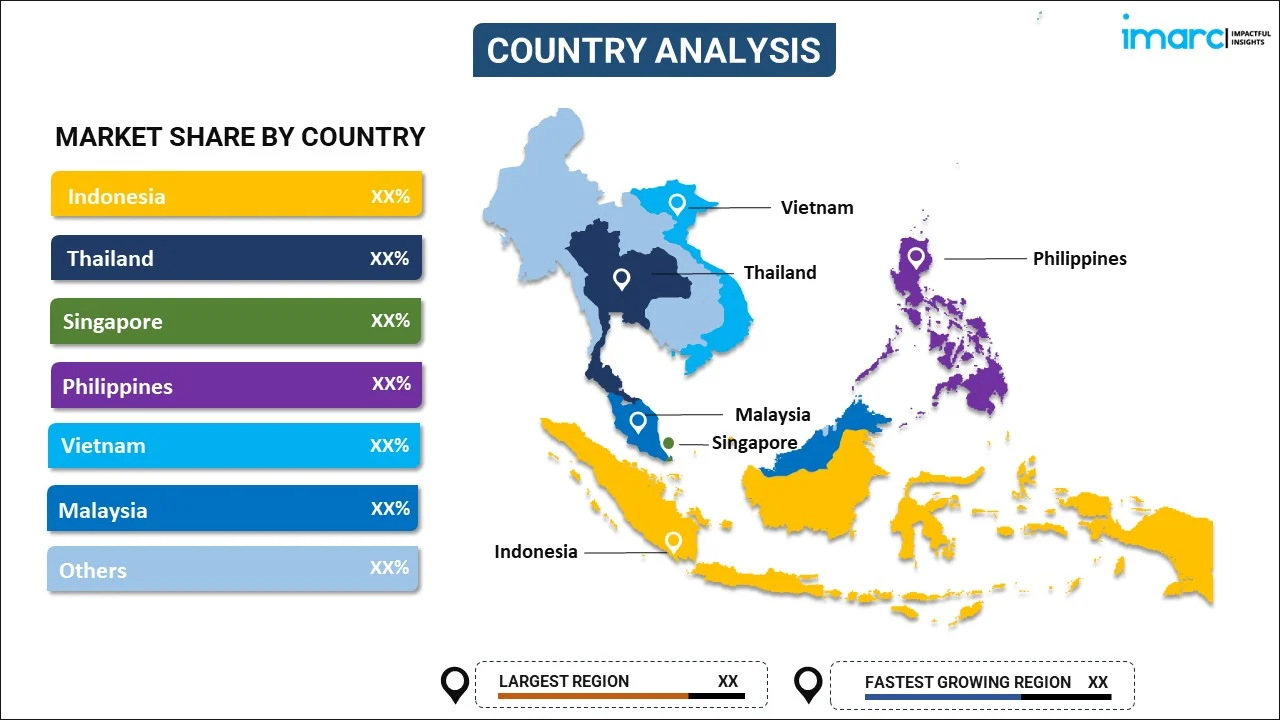
South East Asia Wine Market Report by Product Type (Still Wine, Sparkling Wine, Fortified Wine, and Vermouth), Color (Red Wine, Rose Wine, White Wine), Distribution Channel (Off-Trade, On-Trade), and Country 2024-2032
Market Overview:
South East Asia wine market size is projected to exhibit a growth rate (CAGR) of 4.74% during 2024-2032. The increasing advancements in technology, such as precision viticulture, vineyard management systems, and winemaking techniques, that can improve production efficiency, enhance wine quality, and reduce overall production costs, are driving the market.
|
Report Attribute
|
Key Statistics
|
|---|---|
|
Base Year
|
2023 |
|
Forecast Years
|
2024-2032
|
|
Historical Years
|
2018-2023
|
| Market Growth Rate (2024-2032) | 4.74% |
Wine is an alcoholic beverage crafted through the fermentation of crushed grapes or other fruits. The process of winemaking involves the careful selection of grapes, followed by crushing, fermentation, and aging, all of which contribute to the diverse flavors and aromas found in different wine varieties. Wine has played a significant role in religious ceremonies, cultural practices, and social gatherings throughout history, often symbolizing joy, abundance, and celebration. Its consumption is intertwined with culinary experiences, where it complements and enhances the flavors of various cuisines. Moreover, the art of wine tasting and appreciation has evolved, leading to the establishment of sommelier expertise and a sophisticated culture of wine connoisseurship. As an integral part of the heritage, wine continues to captivate enthusiasts and connoisseurs alike, fostering a deep appreciation for its intricate craftsmanship and the stories it embodies.
South East Asia Wine Market Trends:
The wine market in South East Asia is currently experiencing a surge in demand, primarily driven by shifting consumer preferences. Firstly, with an increased emphasis on health consciousness, consumers are gravitating towards red wine, renowned for its purported cardiovascular benefits. Consequently, this has led to a significant rise in the consumption of red wine. Furthermore, the burgeoning trend of wine as an essential accompaniment to meals has boosted its market growth. Correspondingly, the integration of wine in culinary experiences has elevated its status beyond just a beverage, fostering a culture of wine appreciation. Additionally, the escalating popularity of wine tourism has fueled the market's expansion, as vineyard visits and wine-tasting tours have become sought-after experiences, amplifying consumer engagement and fostering brand loyalty. Moreover, the surging disposable incomes among the middle-class population in South East Asia have led to an increased willingness to spend on premium and luxury wines, stimulating growth in the higher-end wine market segment. Consequently, these multifaceted market drivers collectively contribute to the continuous growth and dynamism of the regional wine market.
South East Asia Wine Market Segmentation:
IMARC Group provides an analysis of the key trends in each segment of the market, along with forecasts at the regional and country level for 2024-2032. Our report has categorized the market based on product type, color, and distribution channel.
Product Type Insights:

- Still Wine
- Sparkling Wine
- Fortified Wine and Vermouth
The report has provided a detailed breakup and analysis of the market based on the product type. This includes still wine, sparkling wine, and fortified wine and vermouth.
Color Insights:
- Red Wine
- Rose Wine
- White Wine
A detailed breakup and analysis of the market based on the color have also been provided in the report. This includes red wine, rose wine, and white wine.
Distribution Channel Insights:
- Off-Trade
- Supermarkets and Hypermarkets
- Specialty Stores
- Online Stores
- Others
- On-Trade
The report has provided a detailed breakup and analysis of the market based on the distribution channel. This includes off-trade (supermarkets and hypermarkets, specialty stores, online stores, and others), and on-trade.
Country Insights:

- Indonesia
- Thailand
- Singapore
- Philippines
- Vietnam
- Malaysia
- Others
The report has also provided a comprehensive analysis of all the major regional markets, which include Indonesia, Thailand, Singapore, Philippines, Vietnam, Malaysia, and Others.
Competitive Landscape:
The market research report has also provided a comprehensive analysis of the competitive landscape. Competitive analysis such as market structure, key player positioning, top winning strategies, competitive dashboard, and company evaluation quadrant has been covered in the report. Also, detailed profiles of all major companies have been provided.
South East Asia Wine Market Report Coverage:
| Report Features | Details |
|---|---|
| Base Year of the Analysis | 2023 |
| Historical Period | 2018-2023 |
| Forecast Period | 2024-2032 |
| Units | US$ Billion |
| Scope of the Report | Exploration of Historical and Forecast Trends, Industry Catalysts and Challenges, Segment-Wise Historical and Predictive Market Assessment:
|
| Product Types Covered | Still Wine, Sparkling Wine, Fortified Wine, and Vermouth |
| Colors Covered | Red Wine, Rose Wine, White Wine |
| Distribution Channels Covered |
|
| Countries Covered | Indonesia, Thailand, Singapore, Philippines, Vietnam, Malaysia, Others |
| Customization Scope | 10% Free Customization |
| Report Price and Purchase Option | Single User License: US$ 3699 Five User License: US$ 4699 Corporate License: US$ 5699 |
| Post-Sale Analyst Support | 10-12 Weeks |
| Delivery Format | PDF and Excel through Email (We can also provide the editable version of the report in PPT/Word format on special request) |
Key Questions Answered in This Report:
- How has the South East Asia wine market performed so far and how will it perform in the coming years?
- What has been the impact of COVID-19 on the South East Asia wine market?
- What is the breakup of the South East Asia wine market on the basis of product type?
- What is the breakup of the South East Asia wine market on the basis of color?
- What is the breakup of the South East Asia wine market on the basis of distribution channel?
- What are the various stages in the value chain of the South East Asia wine market?
- What are the key driving factors and challenges in the South East Asia wine?
- What is the structure of the South East Asia wine market and who are the key players?
- What is the degree of competition in the South East Asia wine market?
Key Benefits for Stakeholders:
- IMARC’s industry report offers a comprehensive quantitative analysis of various market segments, historical and current market trends, market forecasts, and dynamics of the South East Asia wine market from 2018-2032.
- The research report provides the latest information on the market drivers, challenges, and opportunities in the South East Asia wine market.
- Porter's five forces analysis assist stakeholders in assessing the impact of new entrants, competitive rivalry, supplier power, buyer power, and the threat of substitution. It helps stakeholders to analyze the level of competition within the South East Asia wine industry and its attractiveness.
- Competitive landscape allows stakeholders to understand their competitive environment and provides an insight into the current positions of key players in the market.
Need more help?
- Speak to our experienced analysts for insights on the current market scenarios.
- Include additional segments and countries to customize the report as per your requirement.
- Gain an unparalleled competitive advantage in your domain by understanding how to utilize the report and positively impacting your operations and revenue.
- For further assistance, please connect with our analysts.
 Inquire Before Buying
Inquire Before Buying
 Speak to an Analyst
Speak to an Analyst
 Request Brochure
Request Brochure
 Request Customization
Request Customization




.webp)




.webp)












